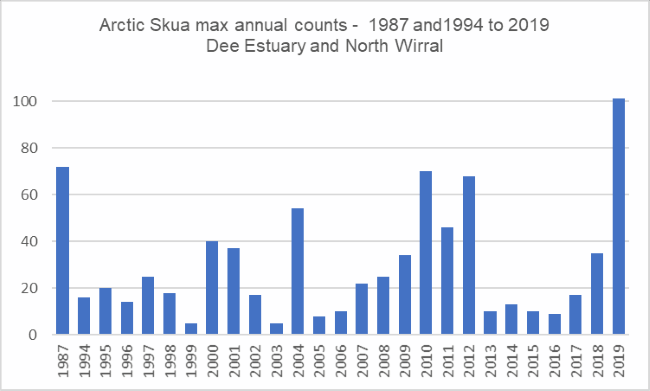Site menu:
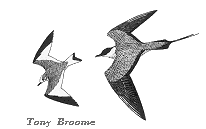
October 2019 Newsletter
Pomarine and Long-tailed Skuas.
Colour Ring Report.
September Bird News.
Forthcoming Events.
Latest Newsletter.
Pomarine and Long-tailed Skuas
plus Arctic and Great Skua update

I certainly chose the right year to write a couple
of articles about skuas and September was particularly good, which is
why I've included another update on Arctic and Great Skuas as well as
writing about Pomarines and Long-tails.
Long-tailed and Pomarine Skuas
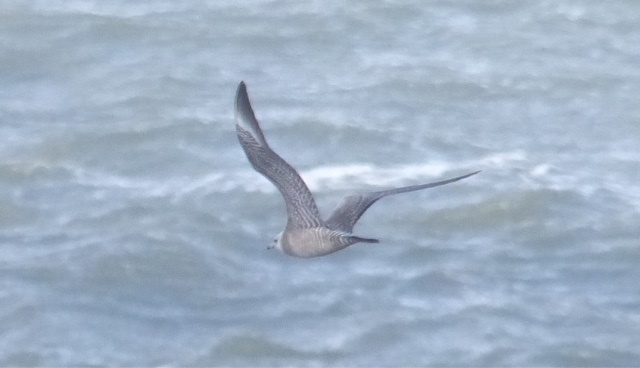
Both these species breed in the Arctic right across the northern hemisphere and spend the winter out to sea, consequently we really have very little idea how many there are but if you said around 400,000 mature individuals for each species you probably wouldn't be too far out. Long-tailed Skuas breed in Scandinavia and it is thought they have attempted to breed in the UK, in contrast the Pomarine Skua breeding range starts further north and east in Arctic Russia. They both feed on Lemmings during the breeding season but have evolved different strategies to cope with the Lemming cycle. Pomarine Skuas will move quite long distances from one year to the next to find areas where lemmings are plentiful. In contrast Long-tailed Skuas often don't bother to breed when lemmings are in short supply, a strategy that has been likened to "skimming the cream" off the lemming's population cycles.
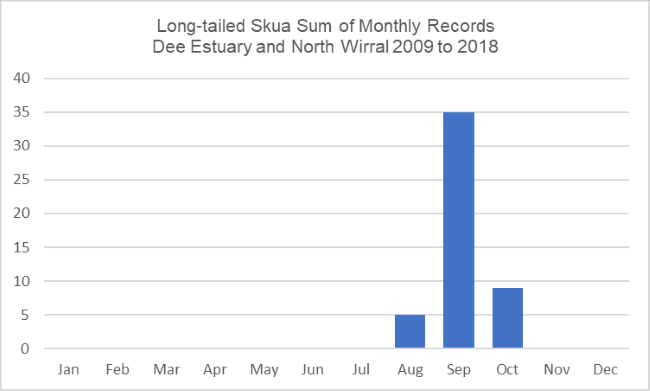

As you can see from the graphs Pomarine Skuas tend
to migrate south later than Long-tailed Skuas. It may well be that the
birds we see in Liverpool Bay have traveled overland from the North
Sea as both species have been tracked flying over the country both in
the spring and autumn. Pomarine Skuas winter out in the Atlantic,
mostly north of the equator, whilst Long-tailed Skuas fly much further
south and recent tracking research shows that many winter in
the Benguela Current off the west coast of southern Africa. Most birds
of both species tend to fly back north west of Ireland and Scotland,
and sometimes
spectacular large mixed flocks are recorded off the Hebrides. In
Liverpool Bay spring and summer records of Long-tailed Skuas are
virtually unheard of whereas Pomarine Skuas are occasionally seen in
spring and we can sometimes get a non-breeding bird or two loitering
off-shore in the summer.
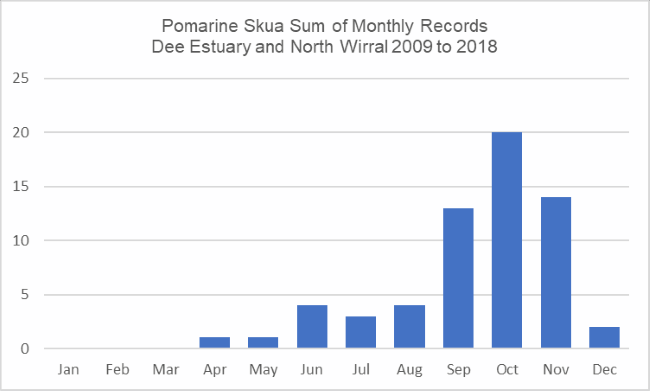
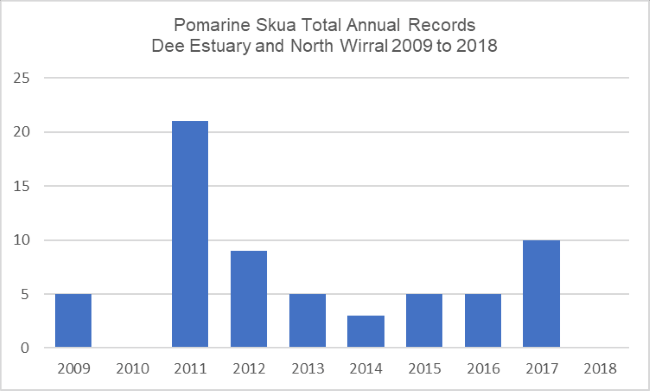
Neither species is quite annual off our coasts,
over the past ten years no Pomarines were recorded in 2010 or 2018 and
Long-tails were missing in 2015 and 2016. Long-tailed Skuas have always
been the rarest skua but in recent years numbers of Pomarine Skuas
seems to have dropped off. Conlin
& Williams
found that the total number of records from 1975 to 1994 was 301
whereas it was only 90 between 1995 and 2015. This is partly explained
by exceptional numbers in 1978 (44 records) and 1988 (49 records) when
there were prolonged north-westerly gales along the north-wirral coast.
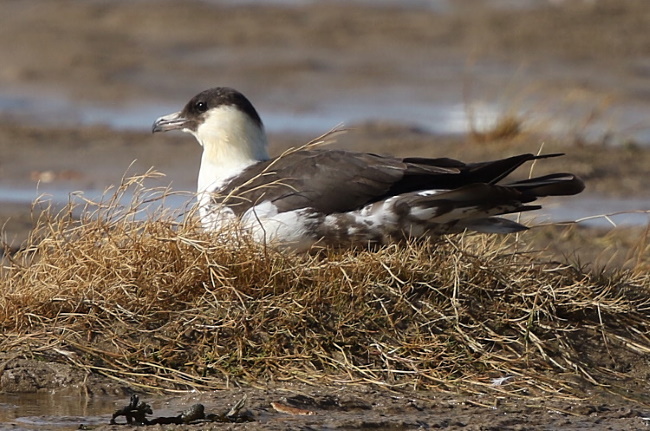
Pomarine Skuas are occasionally seen in the Dee
estuary itself and are not unknown inland. On November 21st 2015 one
was seen flying over Burton Marsh where it was mobbed by a Marsh
Harrier and on October 22nd 2017 birders at the Connah's Quay Nature
Reserve were somewhat surprised to see two flying past the hide.
So far 2019 has been good for both species with a
total of 15 Pomarine Skua records and five Long-tailed Skua records up
to the end of September.
Note: As usual with skuas it has been difficult to know which records to include and which to leave out. There are ID issues, double counting issues and the problem of many observers not bothering to submit records to the rarity committees. In many cases I have had to use my own judgment which records to include but as the vast majority were from two main sources, Hilbre Bird Observatory and the North Wirral 'regulars', it wasn't that difficult. There will be some duplication of birds recorded as they move along the coast so totals may be slightly over-estimated. The records also include those from the Welsh coast, mainly Point of Ayr.
Arctic and Great Skuas - another update
Several days of strong westerlies early in the month, including a day of gales, meant September 2019 was excellent for skuas. This included a record high number of Arctic Skuas with 101 counted on the 4th from Hilbre (previous record being 72 on 12 September 1987) and the total of daily max's was 129 for the first half of September but none for the second half. There were 26 Great Skua records in September. Here are a couple of updated graphs from last month's article to put these in perspective:
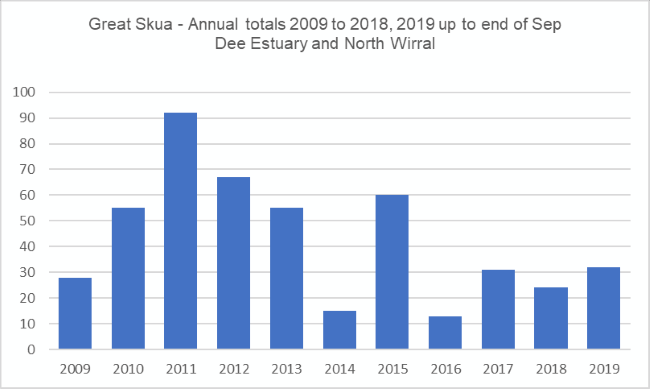
References:
1. Cheshire and Wirral Bird Reports from 1994 to 2017, Cheshire and Wirral Ornithological Society - http://www.cawos.org/ .
2. Long-tailed and Pomarine Skua records from Cheshire and Wirral Ornithological Society database.
3. Skua records in the Dee Estuary latest sightings page (and all who contributed records) - www.deeestuary.co.uk/lsight.htm.
4. Allan Conlin & Eddie Williams, Rare and
Scarce Birds of Cheshire & Wirral, 2017.
5. All About Birds - Long-tailed Jaeger -
https://www.allaboutbirds.org/guide/Long-tailed_Jaeger/overview.
6. Wynn, Russel & Brown, Dan & Thomas, Gavin
& Holt, Chas & Hanssen, Sveinn Are & Gilg, Olivier &
Moe, Børge. (2014). Spring migration routes of Long-tailed Skuas around
and across the UK - results of observational and tracking data. British
Birds. 107. 220-228.
7. David Campbell, Exceptional skua passage in the Outer Hebrides, May 2015, BirdGuides - Click Here.
8. BTO Migration Atlas, Poyser, 2002.
9. Birds of the Western Palearctic (BWPi - interactive edition).
Top of Page
Colour Ring Report
Shelducks
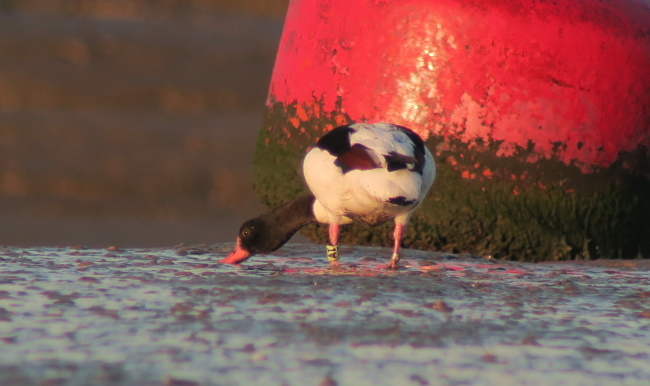
We don't see many colour-ringed wildfowl so it was
with some surprise
that early on this year Steve Hinde started seeing Shelduck with lime
coloured rings on their legs on Thurstaston Shore. Turns out they had
been ringed at Martin Mere and he has now seen a total of eight L
ringed birds, including six in September. This was an unexpected link
between Martin Mere and the Dee estuary. We have recorded them at
Thurstaston in spring and autumn, Kane Brides at WWT Martin Mere tells
us the Shelduck are mostly present at Martin Mere through the winter
months and are likely enticed there by the daily feeding that is aimed
at the swans but all the other wildfowl take advantage. The main aim of
the colour ringing is to get a better understanding of the birds lives
within the extended Liverpool Bay area. Metal ringing alone has
produced almost no data away from Martin Mere. If they can follow the
project through for twenty years then little by little they'll learn a
great deal.
Grey Plovers

With two recent catches of Grey Plover over at Altcar we currently have
more colour-ringed birds of this species in our area than anywhere else
in the country. They are difficult to catch so to catch and ring over
140 was a great achievement, and they are also difficult to get near
enough
to read the letters on the flag with Hoylake at high tide being the
best spot. In September three were recorded including the splendid
looking bird in the photo above.
Richard du Feu, the organiser of the scheme, said "Grey plover are
one of the least studied and therefore monitored wintering waders in
the UK. As such all sightings help increase our understanding of their
winter survival and therefore population drivers. It seem as if the
Grey plover are highly spring site faithful however in Autumn things
are a bit different. In the last week we have had sightings from
Ireland, the Solway and the Humber."
Mediterranean Gull
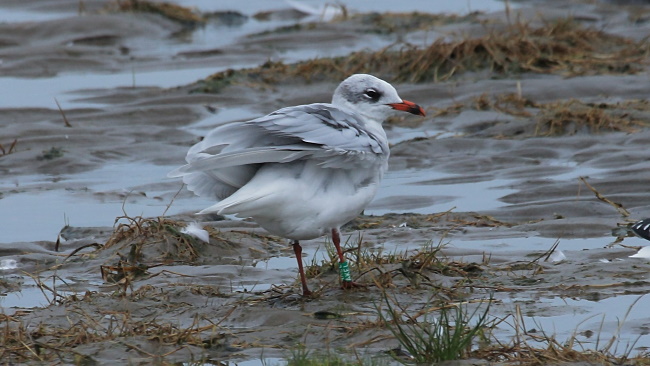
AKEL White on Green ring.
Ringed on Pionierinsel island, Elbe estuary, in Germany in 2012 it was seen there gain in 2015.
Since then it has been recorded at Thurstaston in July 2018 and again on September 23rd 2019 before moving to Hoylake on September 30th.
Black-headed Gull
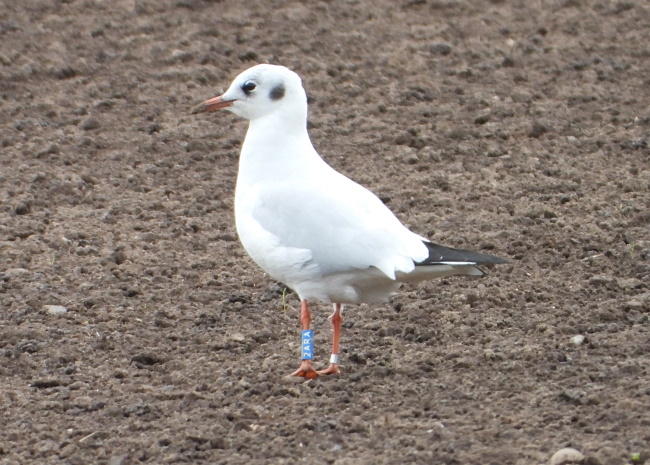
2ARA - white on blue ring.
Ringed at Rutland Water on June 15th 2018.
Recorded at Caldy on September 23rd 2019.
Lloyd Park, the ringer, said: "This was one of around 200+ birds that were marked as part of a new study for Rutland Water. Birds ringed in 2018 have been sighted in Derbyshire, West Ireland, East Lothian, London, North West Spain, Central Spain and Staffordshire."
Colour Ringed birds were recorded by: Richard Smith, Steve Hinde, Carole Killikelly, Dave Winnard, Ken McNiffe, Tony Ormond, Paul Ralston, Jane Turner, Tim Kinch, Les Hall and Steve Williams.
September Bird News
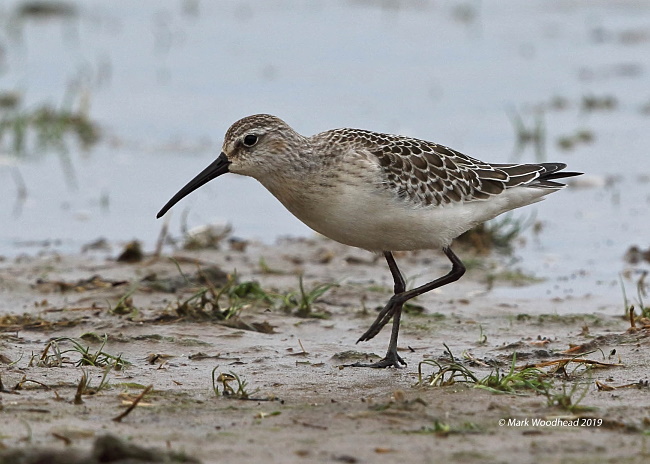
The first week gave some classic September seawatching, there was a
full
blown gale on the 4th and it was on that day we had a record number of
Arctic Skuas (101) as mentioned above. But we also had 32 Leach's
Petrels, Grey Phalaropes, Sabine's Gulls, Manx Shearwaters as well as
the other three species of skuas. Leach's Petrels were recored every
day of that first week, but after that the weather quietened right down
and we could only reflect on how good it could have been if the
gales had continued! We did have an intriguing sighting of a dark
rumped petrel, possibly a Swinhoe's Storm Petrel, flying past Leasowe
on the 6th.
Curlew Sandpiper is another classic September
species but numbers were a bit disappointing, it started off with four
at Hoylake on the first but after that it was just ones and twos at
Hoylake, Heswall and Burton Mere Wetlands. It was similar story with
Little Stints with just one or two at Burton Mere Wetlands for several
days and then one at Hoylake for a few days during the high tides at
the end of the month. A juvenile Dotterel was a good find at Leasowe on
the 14th, unfortunately it didn't stay long.
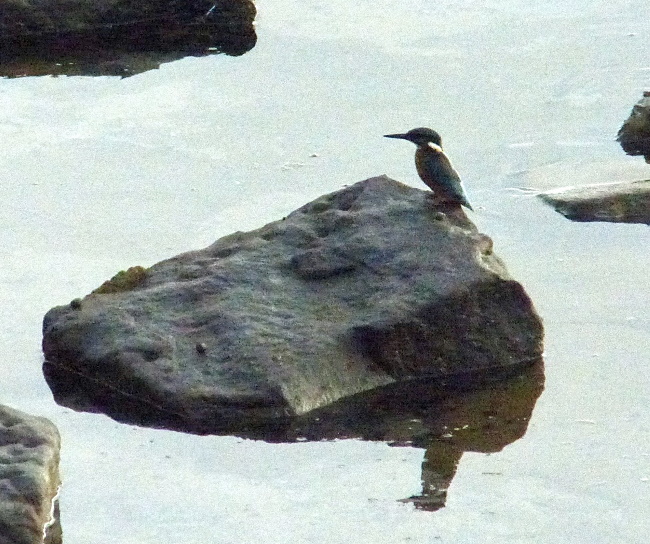
http://hilbrebirdobs.blogspot.com
There was some movement of birds including a dispersal of Kingfishers, one at Hilbre was unexpected but we also saw up to four along the north Wirral coast. The first Pink-footed Geese arrived on the 5th with 54 at Burton Mere Wetlands and these were up to over 200 a week later. There was a large passage of Wheatears on the 16th with birds reported all over the place including 31 on Hilbre. Four Lapland Buntings near Shotwick Lake mid-month were more unexpected.
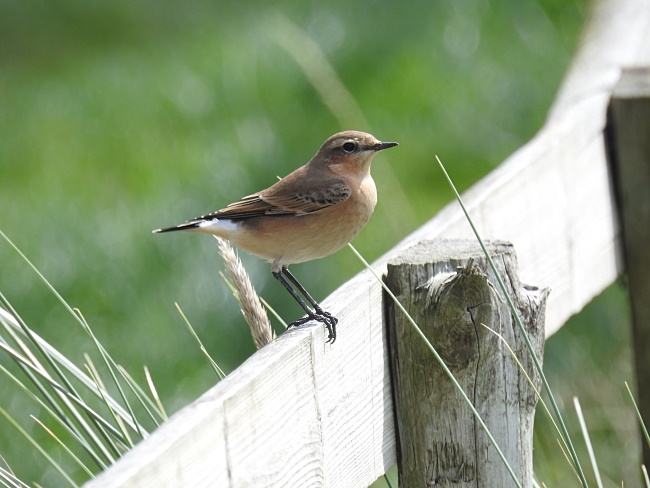
Raptors included several reports of Hobbies, there was also a Red Kite, several records of single Hen Harriers and up to seven Marsh Harriers at Parkgate. Up to seven Spoonbills took up residence at Parkgate and 19 Great Egrets were counted coming into the roost at Burton on the 29th.
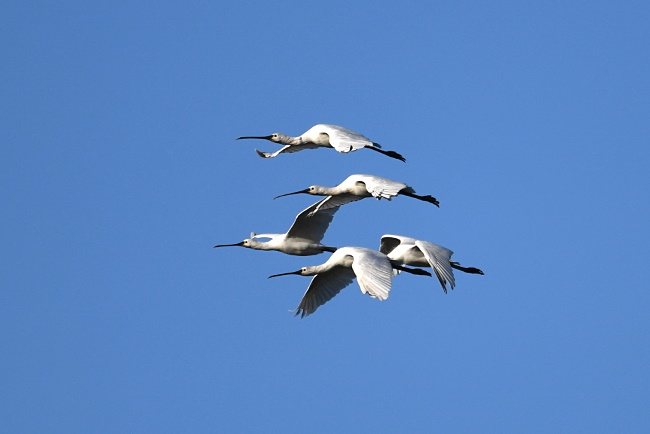
Top of Page
What to expect in October
October is also the best month to see visible migration - usually known as 'VisMis'. Given the right weather conditions, a light south-east wind with a bit of cloud cover, this can be spectacular with early morning being best. We can get flock after flock flying along our coasts including thousands of Meadow Pipits, Starlings, Chaffinches, Fieldfares and Redwings plus just about any other passerine in smaller numbers. Try Leasowe Lighthouse, Red Rocks, Thurstaston country park and Point of Ayr. Fieldfares and Redwings can be particularly numerous at Thurstaston with birds flying across the Mersey estuary from Hale and then dispersing across Wirral. Many more birds move south down the Sefton coast before flying across the Mersey channel to north Wirral.
Out to sea gales can blow in Leach's Petrels, Sabine Gulls, Grey Phalaropes and all four species of skuas. In calmer conditions you may be able to see thousands of Scoters and hundreds of Great Crested Grebes out in Liverpool Bay.
On the marshes Short-eared Owls and Hen Harriers will return, plus plenty of Marsh Harriers which are now resident on the estuary. We may well get a day when Pink-footed Geese arrive en masse flying over Wirral and up the estuary in their thousands, and Brent Geese will be arriving in good numbers at Hilbre.

Forthcoming Events
October Highest Spring Tides (Liverpool)
Also see Tides page.
1st October, 13.38hrs (BST), 9.9m.
2nd October, 14.18hrs (BST), 9.6m.
27th October, 10.09hrs (GMT), 9.7m.
28th October, 10.51hrs (GMT), 9.9m.
29th October, 11.33hrs (GMT), 10.0m.
30th October, 12.13hrs (GMT), 9.8m.
Forthcoming Events
Organised by the Wirral Ranger Service , Flintshire Countryside Service and the RSPB (Dee Estuary): All these events and walks have bird interest, even those not advertised specifically for birdwatching. No need to book for these events unless specified - please check below.
Wednesday 2nd
October, RSPB Point of Ayr
Tidewatch
1pm-3.30pm (approx. finish)
Price: £5 per person (£4 RSPB members) plus Eventbrite booking fee
Booking essential
By October we'll have welcomed many of our winter visitors back to the
mudflats and saltmarsh that make the Dee Estuary such an important home
for wetlands birds, and witnessing a high tide at the Point of Ayr is a
spectacle not to be missed.
Thousands of godwits, redshanks, oystercatchers and curlews gather in
spectacular fashion on the saltmarsh and shingle here at high tide,
which is what we hope to show you if you join us on this gentle walk
from Talacre to our hide. There'll also be a variety of ducks -
pintail, shelduck, teal and mallard - pushed close on the incoming
tide, and there's always the chance that something unexpected will show
its face! Peregrine and merlin are the two raptors most likely to take
advantage of this high tide buffet, so there's a chance of seeing these
hunting at close range.
Park in one of the public car parks signposted from Station Road and
meet outside 'The Point' bar at the end of Station Road. Car parks are
Pay & Display so don't forget some coins. Appropriate clothing and
footwear are essential. The path is fully accessible, but an A-frame
motorcycle gate at the beginning of the walk may make it difficult for
larger wheelchairs. Feel free to pack some snacks or lunch for in the
hide, and a hot flask is recommended at this time of year! Public
toilets and places to purchase refreshments will be available in
Talacre before and afterwards.
Telephone 0151 353 2720 for further information.
Advanced booking and payment is
essential via Eventbrite:
https://poa-october-tidewatch.eventbrite.co.uk
Sunday 13th October
RSPB Raptorwatch at Parkgate.
1pm-dusk
Join us for a chance to see up to seven different birds of prey
including peregrine and merlin, plus two types of owl that all make
their home on the RSPB Dee Estuary nature reserve. With its panoramic
views of the saltmarsh, Parkgate is one of the best places to watch for
the birds hunting. Stick around until dusk for a chance to see the
graceful and endangered hen harriers flying into roost for the night on
the marsh close to the Old Baths car park, plus a ghostly barn owl
emerging to hunt. No booking required, come along any time between 1pm
and sunset. Dress appropriately for the weather and don't forget your
binoculars! Public toilets and various pubs and cafes are situated
close by along Parkgate promenade.
Telephone 0151 353 2720 for further information.
Wednesday 23 October, RSPB Dee
Estuary: Celebrating 40 Years
Doors open 7pm for 7.30pm start
Price: £12 per person (£10 RSPB members), children half price (plus
Eventbrite booking fee)
Venue: The Cranston Suite, Neston Cricket Club, Station Road, Parkgate,
Cheshire, CH64 6QJ
Booking essential
For the final part of the RSPB Dee Estuary reserve's 40th Anniversary
celebrations, join us for an evening of insight and stories from the
men who steered the reserve through those four remarkable decades.
Our original warden from 1979, Bob Gomes joins us alongside his
long-serving successor Colin Wells, who held the reins from 1984 until
his retirement in 2017. Hear their tales of how the reserve developed,
challenges along the way and how years of hard work has seen the
recovery, and arrival, of some iconic wildlife.
Refreshments will be available to purchase from the venue's bar. Places
are limited therefore advance booking and payment is essential via
Eventbrite: https://dee40years.eventbrite.co.uk
Telephone 0151 353 2720 for further information.
Tuesday 29th
October
RSPB High Tide Birdwatch at Parkgate.
10am-2pm
In celebration of the RSPB Dee Estuary reserve's 40th anniversary, join
us at Parkgate Old Baths for the awe-inspiring spectacle of a high tide
flooding the vast saltmarsh, potentially reaching the old sea wall. The
marsh at Parkgate is one of the best wetland habitats in the northwest,
and when flooded by an incoming tide, the wildlife which lives here is
pushed closer, with chance of seeing the great range of ducks, geese,
wading birds and egrets in big numbers as they are driven upstream by
the rising tide. A range of birds of prey take advantage of mice and
voles flushed from the grasses; hen and marsh harriers, peregrines and
merlins all spend the winter months on the estuary and this is one of
the best places to watch them, plus short-eared owls if we're really
lucky. So why not venture out to try witness all the drama. Low
pressure and a westerly wind will help push the tide and wildlife in
close. There is free public parking at the Old Baths car park (CH64
6RN) at the north end of The Parade, and the Wirral Country Park car
park on Station Road (CH64 6QJ). There are public toilets at Mostyn
Square in the middle of The Parade, and a number of pubs and cafes.
High tide is at 11.33am.
Telephone 0151 353 2720 for further information.
Saturday 2nd and
Sunday 3rd November - Wader Conservation World Watch.
Every year on the first weekend of November we celebrate the
Anniversary of the start of Wader Quest, which occurred on the 1st of
November 2012, when Rick and Elis Simpson (founders of Wader Quest)
started their travels to find waders around the world. The celebration
takes the form of an international event – Wader Conservation World Watch. The
first WCWW was in 2014 the year they finished their travels. Each year
since then it has grown in the number of people taking part and also
the number of locations and species counted.
The purpose of WCWW is not just to highlight waders and the problems
they are facing, but also to celebrate the people who are involved,
either professionally or voluntarily, in their conservation. Whether a
person’s involvement is as a researcher, a ringer, a conservationist, a
birdwatcher or a fundraiser, this event is there to say ‘thank you’ to
them and for the participants to say ‘I Care’ about what is happening
to the worlds waders.
For details see:
https://www.waderquest.net/wader-conservation-world-watch/
Sunday 10th
November
RSPB Raptorwatch at Parkgate.
1pm-dusk
Join us for a chance to see up to seven different birds of prey
including peregrine and merlin, plus two types of owl that all make
their home on the RSPB Dee Estuary nature reserve. With its panoramic
views of the saltmarsh, Parkgate is one of the best places to watch for
the birds hunting. Stick around until dusk for a chance to see the
graceful and endangered hen harriers flying into roost for the night on
the marsh close to the Old Baths car park, plus a ghostly barn owl
emerging to hunt. No booking required, come along any time between 1pm
and sunset. Dress appropriately for the weather and don't forget your
binoculars! Public toilets and various pubs and cafes are situated
close by along Parkgate promenade.
Telephone 0151 353 2720 for further information.
